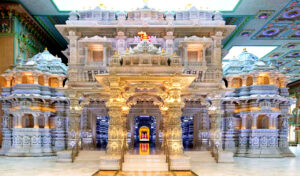
Raksha Bandhan, also known as Rakhi, is a Hindu festival that celebrates the love and duty between brothers and sisters. It is celebrated on the full moon day in the Hindu month of Shravana, which typically falls in August.
In Sanskrit, “Raksha Bandhan” literally translates to “the knot of protection.” Though the rituals vary across geographic locations, they all incorporate the tying of a thread. On this day, sisters tie a rakhi (sacred thread) on their brothers’ wrists as a symbol of their lifelong vow to protect each other. Brothers in turn give their sisters gifts and promises of protection. Raksha Bandhan reinforces the bond between brothers and sisters and is an affirmation of their duty and affection for one another.
The festival has its origins in mythology but over time has also come to signify the larger concept of brotherhood and its personal, familial and social values. Various stories trace the history of Raksha Bandhan.
Krishna and Draupadi
One story is about how Lord Krishna cut his finger while handling a weapon, and Draupadi, the wife of the Pandavas, tore a strip of cloth from her sari and tied it around Krishna’s cut finger to stop the flow of blood. Krishna was so touched by her gesture that he promised to protect her. Since then, the protection tied by a sister has come to be called a ‘raksha’ (protection) and the material used to tie that protection has been called a ‘rakhi’.
Lakshmi and Bali
In the Bhagavat Puran and Vishnu Puran, after Vishnu conquers the three world from King Bali, King Bali asks Vishnu to live in his palace. Goddess Lakshmi, Vishnu’s wife, is not happy about this arrangement. She ties a rakhi on King Bali making him a brother. Honored by the gesture, King Bali grants her a wish. Lakshmi requests that Vishnu return home.
Sachi and Indra
In the Bhavishya Puran scripture, Sachi, the wife of Indra, tied a thread around Indra’s wrist to protect him in battle against the powerful demon King Bali. This story suggests that holy threads may have served as amulets in ancient India, used by women to protect men going to war, and not just limited to brother-sister relationships.
Shubh, Labh, and Santoshi Maa
On Raksha Bandhan, Ganesh’s sister, Devi Manasa, came to visit. She tied a Rakhi on Ganesh’s wrist. Ganesh’s sons, Shubh and Labh, were taken by this beautiful tradition, but were angry that they did not have a sister. They begged their father for a sister so that they, too, could participate in the Raksha Bandhan celebration. After much convincing, Ganesh obliges. Santoshi Maa is created, and the three siblings celebrate Raksha Bandhan every year thereafter.
Over time, this tradition expanded beyond just sibling love to include a vow of life-long protection by brothers for their sisters. In India, rakhi is not limited to only blood relatives but can transcend age and caste barriers. This extension of the tradition has helped strengthen social bonds between communities.
Raksha Bandhan is an occasion for family gatherings. On this day, married women travel back to their parents’ homes along with their children. Brothers welcome their sisters with love and traditionally present them with gifts and token amounts of cash. Sisters prepare special food for the occasion, along with beautifully decorated rakhis for the ceremony. They perform the rituals, apply tilak on their brother’s forehead and tie rakhis on their wrists while saying prayers for their well-being. Brothers vow to stand by their sisters through thick and thin.
In modern urban settings, with families becoming nuclear, the tradition of tying rakhi has become more symbolic but nevertheless is seen as an important affirmation of the sibling bond. The fervour of celebrations with family get-togethers, exchange of gifts and feasts has remained intact over the generations. Many also exchange rakhis and gifts through mail if they are separated by long distances.
Raksha Bandhan is deeply embedded in the cultural ethos of India and valorizes the spirit of kinship, brotherhood and unity. The festival strengthens social harmony beyond just the family and brings people together across communities. Its traditions and associated mythological stories interconnect human values and bonds with duty, care, protection, nourishment, trust, commitment and loyalty. The rituals and celebrations foster an environment of joy, care and belonging and enable people to reconnect with their relationships. Over time, the festival has also come to represent spiritual ties and solidarity that transcends caste, creed, distance and age. For society as a whole, it affirms the VALUES and IDEALS that uphold communities and social cohesion.






